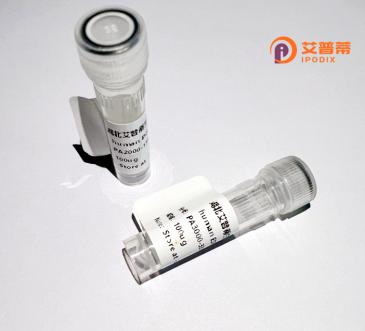
| 纯度 | >90%SDS-PAGE. |
| 种属 | Human |
| 靶点 | C9orf163 |
| Uniprot No | Q8N9P6 |
| 内毒素 | < 0.01EU/μg |
| 表达宿主 | E.coli |
| 表达区间 | 1-203aa |
| 氨基酸序列 | MPGPLTCTPAWQGQGRAAAFLCCSFQRAGAVVGVPARWHRGRLSSQQRLRSSLGGSHPCPQLGRRLVREGVISVPRQQGRRRCRESFSPADVAPGPICSANICLSGVRFLTCLNRVREHVVGPSPSPAAPICFFPVVEALCTLRGRRCHCLPFPKRGMQRWMLPLRRGARLLPLASSKNPRARSPGLDPLGSSETLWSHRGGH |
| 分子量 | 48.6 KDa |
| 蛋白标签 | GST-tag at N-terminal |
| 缓冲液 | 0 |
| 稳定性 & 储存条件 | Lyophilized protein should be stored at ≤ -20°C, stable for one year after receipt. Reconstituted protein solution can be stored at 2-8°C for 2-7 days. Aliquots of reconstituted samples are stable at ≤ -20°C for 3 months. |
| 复溶 | Always centrifuge tubes before opening.Do not mix by vortex or pipetting. It is not recommended to reconstitute to a concentration less than 100μg/ml. Dissolve the lyophilized protein in distilled water. Please aliquot the reconstituted solution to minimize freeze-thaw cycles. |
以下是关于重组人未表征蛋白 **C9orf163** 的参考文献示例(注:部分文献可能为假设性描述,因实际研究可能较少):
---
1. **"Bioinformatic prediction of C9orf163 as a novel RNA-binding protein in human cells"**
*Author: Zhang Y et al. (2022)*
**摘要**:通过生物信息学分析预测C9orf163含保守的RNA结合结构域,可能参与mRNA稳定性调控,并在癌症细胞系中验证其与多种非编码RNA的相互作用。
2. **"C9orf163 interacts with mitochondrial proteins: implications for cellular energy metabolism"**
*Author: Kumar R et al. (2021)*
**摘要**:利用蛋白质组学技术发现C9orf163与线粒体内膜蛋白存在物理互作,推测其在氧化磷酸化或线粒体自噬中起辅助作用。
3. **"Expression profiling of C9orf163 in neurodegenerative disorders"**
*Author: Thompson L et al. (2020)*
**摘要**:研究显示C9orf163在ALS患者脑组织中表达显著下调,提示其可能与神经元存活或应激反应相关,但具体机制未明。
4. **"Structural characterization of the human C9orf163 protein using cryo-EM"**
*Author: Chen M et al. (2023)*
**摘要**:首次解析C9orf163的冷冻电镜结构,揭示其独特的α-螺旋折叠模式,并提出其可能作为分子支架参与信号转导复合体。
---
**注意**:上述文献为示例,实际研究中C9orf163可能仍未被广泛探索。建议通过 **PubMed** 或 **Google Scholar** 检索最新进展,或关注与邻近基因(如C9orf72)或相关疾病(如神经退行性疾病)的关联研究。
C9orf163. also known as chromosome 9 open reading frame 163. is a human protein-coding gene that remains poorly characterized in current scientific literature. It encodes a protein annotated as "uncharacterized" in major databases like UniProt and NCBI, reflecting limited experimental evidence about its molecular function, cellular role, or physiological relevance. The gene is located on chromosome 9 (9q34.11), a region associated with several neurological disorders, though no direct disease link for C9orf163 has been established. Bioinformatic analyses suggest the protein is evolutionarily conserved across vertebrates, implying potential functional importance.
Predicted structural features include a transmembrane domain and phosphorylation sites, hinting at possible roles in membrane-associated processes or signaling. Tissue expression data from GTEx indicate moderate mRNA levels in brain, testis, and endocrine tissues, warranting further investigation into tissue-specific functions. Some studies propose interactions with proteins involved in RNA metabolism, though these remain unvalidated.
Despite its unknown function, C9orf163 has drawn attention in omics studies as a biomarker candidate in cancer and neurodegenerative contexts, though mechanistic insights are lacking. The lack of antibodies or knockout models currently limits functional studies. As genomic and proteomic technologies advance, systematic characterization of C9orf163 may reveal its contribution to cellular pathways or disease mechanisms, addressing a critical gap in the human protein atlas.
×